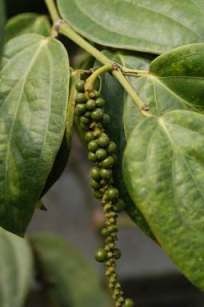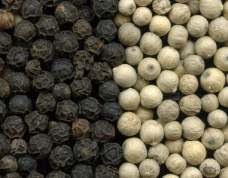Black Pepper
 Common Names: Black pepper, peppercornn
Common Names: Black pepper, peppercornn
Scientific Name: Piper nigrum
Climate: Tropical, Humid Warm
Plant Description: It is a climbing perennial that can grow more than four meters high. Black pepper may be vining or have bushy, wooden stems. The leaves are oblong, pointy at the tip and arranged alternately. White flowers are tiny and mainly hermaphrodite (both sexes in one flower). The flowers converge into oblong spikes that then form clusters. The fruit is a monosperm small berry, first it has a green color that changes to a yellowish, then orange and finally red when ripe. Once dried it is black in color. Pepper plants have a shallow root system. Usually there are some important lateral roots that can penetrate the soil to a depth of two meters.
Black Pepper is native to South India.
Cultivation:
It grows in semi-shade or in the place with few hours of the sun a day. It needs well drained soils with friable texture low acidity (with ph between 5.5 - 6.0). It prefers slightly sloping terrain for natural drainage and where it can retain moisture. Black pepper likes warm areas with high precipitation. It does not support prolonged periods of drought. It will not grow where the temperature drops below 12 ° C.
It is propagated by seed, layers and cuttings.
Reproduction by seed is rarely used because the seed produces plants that are varied and different from the mother plant. These plants start to produce much later (in 7 years), and have a shorter life.
It can be easily planted by layering. it is only necessary to extend the stem in the ground, so that each knot takes root on contact with the ground. You can also obtain orthotropic stalk air layers as a means of multiplication of the plant, which are true well-developed steels. In order to do this, the bark is removed, and a little wet sawdust is put on, then it is wrapped with aluminum foil or nylon or fine and transparent plastic. It will root in 45-60 days.1 When it is ready it is placed in nursery bags, or can be taken to the field during the rainy season.
Propagation by cuttings: Choose a vigorous and productive plant that is not more than five years old. Cuttings with three to four knots are selected, these need to come from vertical stems or main vine. They should not have leaves or branches and have to be cut at the base of a knot. Cuttings should be kept in a place with 50 to 75% shade and high humidity irrigating them when necessary.2 It is recommended to put some natural fungicide and plant them in polyethylene or black plastic bags 24 cm high by 16 cm in diameter. The bags should have enough holes to promote drainage and filled with growth-stimulating soil to accelerate rooting. The soil for the bags must be previously treated with a fungicide (3 tablespoons of baking soda in 4 liters of water) to avoid root diseases. Once rooted, the cuttings are transferred to a suitable place for acclimatization for a period of approximately three months. Finally, when they are about 25 to 30 cm high, they are planted in the final field. To do this, 30 cm holes are made in all three dimensions, at a distance between 15 and 30 cm from the support. Planting is recommended at the beginning of the rains.
Black pepper plants are climbers, so they need support for their growth. Live tutors such as black wood trees or simple posts can serve as support.
Black pepper needs to be fertilized frequently with organic material made up of plant residues that were digested by livestock and then composted at the site. You can also add the compost soil and earthworm humus.
Plants are pruned for their health and to reduce the growth of their corridors. Young plants can only retain 3 main corridors. To strengthen these corridors of older plants they should be pruned back to 7 internodes. Long secondary runners hanging from the top should be pruned every year.
Ripe berries are harvested 9 months after flowering. They ripen over a period of 2 to 3 months. The berries are green at first, turn yellow, and then red when fully ripe. The berries are harvested every 7 to 14 days. Pepper spikes are picked when one or two of the berries on the spike start to turn orange and the berries are hard to touch. All berry spikes are picked by hand. The flavor and acidity of the pepper develop as the berries ripen. Pepper berries can be harvested while they are still green, but dried peppercorns will have less heat and flavor than berries harvested later. The berries are spread out on platforms to dry in direct sunlight for a period of about a week and a half. They can also be dried using a solar dryer or a combination of a solar dryer and wood dryer.3
The first yield of the cuttings is harvested from the third year and the maximum yield from the seventh year. 4
 Uses: As it gives food a spicy and aromatic flavor black pepper is used in the kitchens all over the world. However, it also has medicinal qualities that benefit our health. The spicy and warming properties of black pepper help metabolize food during the digestion process. Its heat works as a stimulant.5 This stimulating quality serves to eliminate congestion in the respiratory system. It works because its stimulating properties help to expectorate and dry the mucous membranes.6 Piperine, found in black pepper, has an antioxidant and antibacterial effect and helps with digestion and weight loss. It is because it stimulates the breakdown of fat cells.7 Black pepper is also used to treat fungi and against parasites.
Uses: As it gives food a spicy and aromatic flavor black pepper is used in the kitchens all over the world. However, it also has medicinal qualities that benefit our health. The spicy and warming properties of black pepper help metabolize food during the digestion process. Its heat works as a stimulant.5 This stimulating quality serves to eliminate congestion in the respiratory system. It works because its stimulating properties help to expectorate and dry the mucous membranes.6 Piperine, found in black pepper, has an antioxidant and antibacterial effect and helps with digestion and weight loss. It is because it stimulates the breakdown of fat cells.7 Black pepper is also used to treat fungi and against parasites.
Pests and Diseases: The main diseases of this crop are those that attack the root. The most important are those caused by the fungi Phytophthora, Rosellinia and Furasium. The best way to fight against these diseases is the preventive one: promoting good drainage, avoiding covering the neck of the plants with mulch, avoiding root injuries when carrying out cultural tasks. The use of machetes to weed the slices should be avoided. Also avoid leaving a cover in the grooves because it favors the infiltration of water and does not allow runoff.8
References:
- https://bdigital.zamorano.edu/bitstream/11036/2556/1/210912_0236%20pimienta%20negra.pdf
- http://www.mag.go.cr/bibliotecavirtual/F01-0658pimienta.pdf
- https://www.ctc-n.org/sites/www.ctc-n.org/files/resources/pepper_processing.pdf
- https://www.nda.agric.za/docs/Infopaks/pepper.htm
- Ayurveda: The Science of Self Healing: A Practical Guide Paperback – January 1, 1985
- Frawley, David, and Vasant Lad. (1986). The Yoga of Herbs. Twin Lakes, WI: Lotus Press.
- Current Cardiology Review 2010 Nov; 6(4): 274–279. Indian Spices for Healthy Heart - An Overview Hannah R Vasanthi* and R.P Parameswari
- Aspectos Técnicos sobre Cuarenta y Cinco Cultivos Agrícolas de Costa Rica. Dirección General de Investigación y Extensión Agrícola. Ministerio de Agricultura y Ganadería. San José, Costa Rica. 1991
En español: Pimienta Negra
